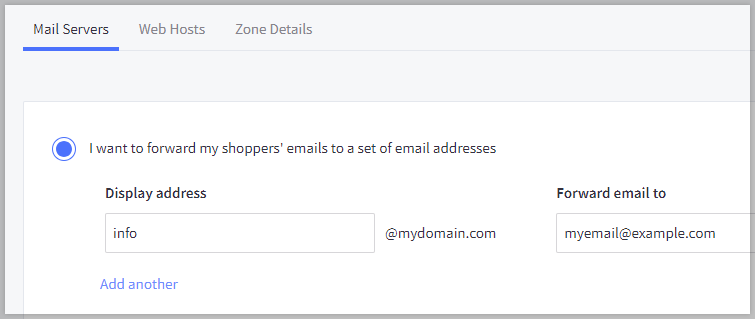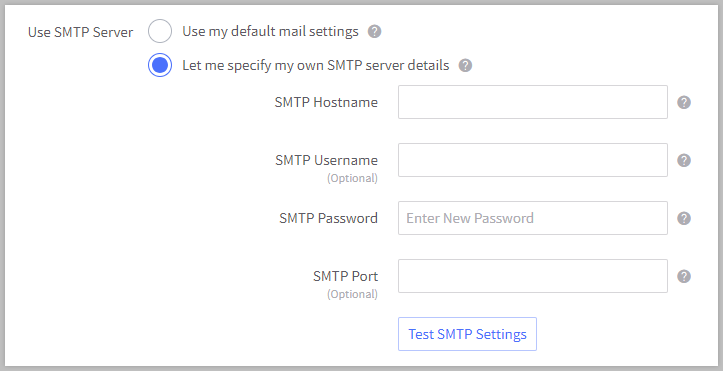The email addresses associated with your store (for customer support purposes, order inquiries, and such) should use your store's domain. Doing this is professional and gives customers confidence that they are contacting a legitimate store representative. When you create your store, BigCommerce will automatically set up a forwarding address so you can start receiving emails right away. You will be able to create up to five custom forwarding addresses.
Before launching your store, we recommend setting up a third-party email service like Google Workspace. These services offer additional features like webmail, filters, and spam blocking, and can scale up as your business grows. BigCommerce does not offer email services.
Store Email Addresses
As email is a crucial part of running your business and communicating with customers, there are several areas between the control panel and account dashboard where you will need to enter email addresses, including:
- Store Profile email — is located under Settings › Store Profile of the control panel. It is used by all emails sent by your store, such as invoices and order status updates.
- Administrator email — is located under the Miscellaneous tab in Settings › General of the control panel. It is the email address where all system notifications are sent, unless specified otherwise.
- Order Notifications email — is located in Settings › Order notifications, under Notification Methods.
- Contact form email — is located in Channel Manager. By default, the “Email Questions to” field is pre-filled with the Administrator’s Email address. You may enter multiple email addresses for contact submissions.
- Primary Contact email — is located in the Account Dashboard. It is the primary email address used for communications from BigCommerce.
- Billing Contact email — is located in the Account Dashboard. It is the email address that receives billing-related emails, such as invoices and payment notifications from BigCommerce.
Forwarding Email
Your forwarding accounts are located in Settings › Email & DNS records. Under the Mail Servers tab, you will see fields for forwarding email addresses. By default, info@yourdomain.com will be set up to forward emails to the email address used to create your store. This can be replaced with a different email address if you prefer.

Click Add another to create an additional email forward. Note that you can forward multiple email addresses to the same email. Send a test email from a different email account to the Display address you've just set up. Don't test with the email address entered in Forwarding email to, or your email may get stuck in a forwarding loop.
If you are using a third-party email service, you will not be able to use BigCommerce's built-in email forwarding. Most mail services offer forwarding through their dashboard.
Email in BigCommerce
The BigCommerce platform sends email on behalf of your store, such as order confirmations, password resets, order status changes, and more. All storefront email is sent from the BigCommerce mail servers unless you have set up custom SMTP servers, in which case your mail host’s servers will handle all outgoing traffic.
When an email is sent, verifications take place to check if the mail is authenticated by the sender. During verification, the recipient's email provider uses certain DNS records (SPF, DKIM, and DMARC records) to authenticate the mail as legitimate business communication. Mail that is not verified can be routed to spam folders or rejected by the recipient's mail servers and returned as a bounceback.
SPF Records
SPF records are used to confirm that a sender is authorized to send emails from a domain. A BigCommerce SPF record is automatically created for new stores, and no changes are needed if you do not have a third-party email service.
If you have your domain pointed to BigCommerce via CNAME or A Record, your DNS records are managed in your registrar’s dashboard. Contact your registrar’s support team if you need assistance with creating or editing DNS records.
If you have your domain pointed to BigCommerce via nameservers, go to Settings › Email & DNS records, then select the Web Hosts tab to manage your records.
Only one SPF record can exist at a time, though you can combine multiple records into a single record. If you have a third-party email host, this means adding include:_spf.bigcommerce.com to your host’s record. At minimum, ensure that your record contains the default listed below. To update an existing TXT record containing v=spf1, add the new SPF record to the Value text. For example:
- Default — v=spf1 +a +mx include:_spf.bigcommerce.com ~all
- Updated — v=spf1 +a +mx include:_spf.bigcommerce.com include:_NEW-SPF-RECORD ~all

DKIM Records
DKIM records are used as a digital signature to show that the email hasn’t been tampered with after being sent. BigCommerce signs all outgoing store emails with DKIM keys. No additional configuration is required.
DMARC Records
A DMARC record tells a mail server how to handle an email, such as labeling it as spam, after checking the email against SPF and DKIM records.
A basic DMARC policy is all that is needed to satisfy most authentication requirements, such as those enforced by Yahoo and Google. However, you are free to craft and customize a DMARC policy that suits your business needs. Any such customization is outside of the scope of our support.
Use the following settings to create a basic DMARC record:
- Type — TXT
- Fully Qualified Host — _dmarc.yourdomain.com
- Value — v=DMARC1; p=none
- Time to live — 900

Custom SMTP Servers
If your third-party email service provides you with SMTP login details, you can use them to send your store's emails through that host's servers, such as invoices and order updates. This can provide you with better logging ability when determining exactly when an email was sent and is useful if you have email spoofing protections in place on your business email.
Be careful! Ensure that SPF, DKIM, and DMARC records are appropriately configured for your mail server. If these are not set up properly, mail may be routed to spam folders or rejected by the recipient's mail servers and returned as a bounceback.
Requirements
- Your custom SMTP server must be using a secure connection.
- TCP Port 25 is not allowed.
Setup Steps
1. Go to Settings › Miscellaneous and under Use SMTP Server, select Let me specify my own SMTP server details.
2. Enter the SMTP server details provided by your mail host along with your user name and password.
3. Click Test SMTP Settings. A test email will be sent to the address entered under Administrator’s Email.
4. Save your changes.

- SMTP Hostname — if the server supports SSL or TLS, prefix the hostname with starttls:// For example, starttls://mysite.com
- SMTP Username — enter if your server requires authentication
- SMTP Password — enter if your server requires authentication
- SMTP Port — enter to use a non-standard SMTP port
FAQ
Can I use DomainKeys Identified Mail (DKIM) and Domain-based Message Authentication, Reporting and Conformance (DMARC) records with my gmail.com or yahoo.com email address?
BigCommerce does not support DKIM and DMARC records for free third-party email services like Yahoo or Gmail. We strongly recommend that your store email addresses use your domain name in order to prevent email delivery errors with customer notifications.
With Multi-Storefront, can I set up custom SMTP servers per storefront?
No. Custom SMTP server settings are shared across all storefronts within a store. Your SMTP provider, such as Google, may allow for mail to automatically be sent from a different validated address.


